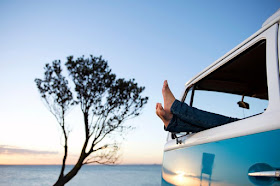5 Weather Conditions
that Influence Comfort the Most
These
conditions control whether you're too hot, too cold, or just right
We all check our local weather forecast
daily to know what to wear.
But when you do, what weather variables do
you pay most attention to?
Air temperature? Air
pressure? Chance of rain?
If you really want to know how cold, warm,
comfortable, or uncomfortable you'll feel when you walk outdoors, be sure to
watch the observations for these 5 weather variables which influence your
comfort the most:
1. AIR TEMPERATURE
One of the primary factors in determining
how comfortable you feel outdoors is temperature.
After all, air sits
next to your skin or the thin layer of clothing in-between the two.
If air temperatures are cool or cold,
you'll shiver and feel cold as a result of your body moving heat to the
surrounding air (by conduction) which makes it gradually lose internal heat.
If air temperatures are too warm, you'll
feel overheated and uncomfortably warm. That's because your body has trouble
releasing the excess heat that builds in it out into the surrounding air.
While we all have a slightly different
temperature we're comfortable at, this range tends to fall between 68° and
78°F.
2. SUNNY SKIES
If sky conditions will be clear with
abundant sunshine, expect to feel much warmer than whatever the air temperature
is.
Why? When direct sunlight shines on you,
the sun's ultraviolet and electromagnetic radiation is being embedded directly
into your skin.
(For this same reason, you should never
place thermometers in direct sunlight when measuring air temperature. If you
do, you'll get an inflated temperature reading!)
3. WIND
Wind makes you feel cooler by evaporating
moisture from the body. (Since wind absorbs latent heat away from the body, you
feel cooler.)
While you might not realize it, your skin
always has some amount of moisture on it and constantly has water evaporated
from it; wind just intensifies this process.
If a breeze blows on a hot summer's day,
wind's cooling power can be a godsend.
But during winter, winds can make
temperatures feel dangerously colder than they actually are -- a phenomenon
known as the wind chill.
4. HUMIDITY
Humidity, or the amount of moisture in the
air, makes you feel hotter.
When humidity is high, evaporational
cooling is reduced and heat builds in the body.
While a a better of is the dew point
temperature. As a rule of thumb, if the higher
the dew point climbs above 60° F, the more muggy and miserable the
air will feel. When dew point values are below 40°F, the air is considered to
be comfortably dry.
The combination of high temperatures and
high humidity makes temperatures feel dangerously hotter than they actually are
-- a phenomenon known as the heat index.
5. CLOUDS
A cloud-filled sky can either make you
warmer or cooler, depending on what time of day the clouds roll in.
If the day starts off and stays cloudy, the
cloud cover will block the sun's heat by reflecting it back out into space and
not allowing surface air temperatures to warm as much as they otherwise would.
If, however, clouds move in sometime
between 10AM to 3PM (the time frame when the maximum heating of the day takes
place) and remain overnight, they can trap heat near the ground, encouraging
the balmy temperatures reached earlier in the day to linger into the nighttime
hours.
TAKING CONTROL OF YOUR OUTDOOR COMFORT
Face it: you can't
change the weather.
But by knowing how it affects you (as
discussed above), you can work around it and plan accordingly.
So the next time you're outdoors and are
feeling too hot, take control of your comfort by doing any one of the
following: stepping out of direct sunlight, catching a breeze, or waiting for
the temperature or humidity to decrease will all help you cool down.
On the other hand, if you're cold, we
advise stepping into the sun, sheltering from the wind, or waiting for the
temperature and or humidity to climb.
Tiffany
Means is a meteorologist, science writer, and avid cloud
watcher/photographer.
https://www.thoughtco.com/weather-conditions-that-influence-comfort-4038624
.
History of the Thermometer
CLICK HERE . . .
CLICK HERE . . .
..
.
CLICK HERE . . .
 |
Multi-Media Filter, Highly-Activated Carbon Filter,
Zeolite-Process Water Softener With Brine Tank,
Fiberglass Ballast-Type Pressure Tank
(fully automatic backwash & regeneration)
|
PURICARE
Water
Treatment
Systems
.
.
...
Aganan, Pavia, Iloilo, Philippines
...
CLICK HERE . . . to view company profile . . .
CLICK HERE . . . to view company profile . . .













No comments:
Post a Comment